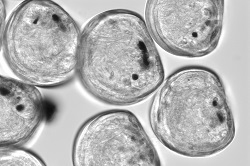The real effects of nanoparticles in their environment
Seawater presents a unique situation due to the ions and organic matter present that may interact with nanoparticles (NPs) and interfere with their mode of action. Researchers used an ingenious in vivo natural water exposure system to test the effects of metal oxide NPs. SOS-Nano used Japanese oyster (Crassostrea gigas) larvae. Professor Tamara Galloway, project coordinator outlines the reason for choosing C. gigas, “Because oyster larvae filter feed from very early in development, they can be used to model the bioavailability (uptake into an organism) and effects of particles including their ability to induce oxidative stress or to alter development.” Testing two different models to determine ecotoxic effects Two structure activity paradigms were investigated – one involved measurement of dissolution and bandgap energies as predictors of oxidative stress. The other gauged oxidative stress generation as a toxicological pathway for predicting health impairment. In addition, the team tested the ions, organic materials and proteins found in seawater to see if they ameliorated the effects of NPs. Project results verified that, in addition to physico-chemical properties responsible for their mode of action, additional NP properties need to be taken into account when predicting their toxicity in seawater. Data on NP behaviour, fate and impact in realistic scenarios A comprehensive project database holds information on the primary physico-chemical properties of the model NPs as well as their secondary properties and oxidation activity in seawater. Using the highest resolution imaging techniques, the ingestion and internalisation of NPs in the larvae was traced. Dissolution tests and abiotic measurement of redox activity enabled assessment of the actual NP mode of action. Two NPs – zinc oxide (ZnO) and manganese dioxide (MnO2) – were investigated to represent the target modes of action, dissolution and bandgap. The oyster larvae suffered high toxicity from ZnO as dissolution was not prevented by seawater. Interestingly, this mode of action can be mitigated by organic matter. In contrast, MnO2 NPs rely on surface redox activity and were not toxic under all exposure scenarios. “Our experiments highlighted how salinity can be a key factor in the toxicological behaviour of redox related modes of action in marine environments via sorption of ions to reactive sites,” comments Prof. Galloway. Expansion of the range of ions under test Throughout the two-year project, SOS-Nano researchers have tackled a large and complex series of experiments using a wide range of state-of-the-art technologies. “Meticulous timing of coordination within the time was required and this was very challenging,” points out Prof. Galloway. Project results show that there is now a firm foundation of paradigm validation on toxicity of two metal oxide NPs in the oyster embryo larvae, a remarkably sensitive organism to the effects of NPs. Future testing would build on this and extend the range of nanomaterials under test, sharing the mode of action but differing in their ability to interact with seawater components. Based on the observations on internalisation in the larvae, changes in NP physico-chemical properties along their way from marine to biological environments and back would also yield valuable information on NP toxicity. Lack of a sound human and environmental risk assessment of NPs is now the major limitation to the safe growth of this economic sector, one of the six EU Key Enabling Technologies selected by the EU Commission. As such, the SOS-Nano project has addressed one of the most cutting-edge issues of econanotoxicology. “Once the mechanisms behind oxidation potential of NPs are clarified, this can lead to new paradigms or the adjustment of existing models,” Prof. Galloway predicts.
Keywords
SOS-Nano, NP, seawater, oxidative stress, dissolution, metal oxide







